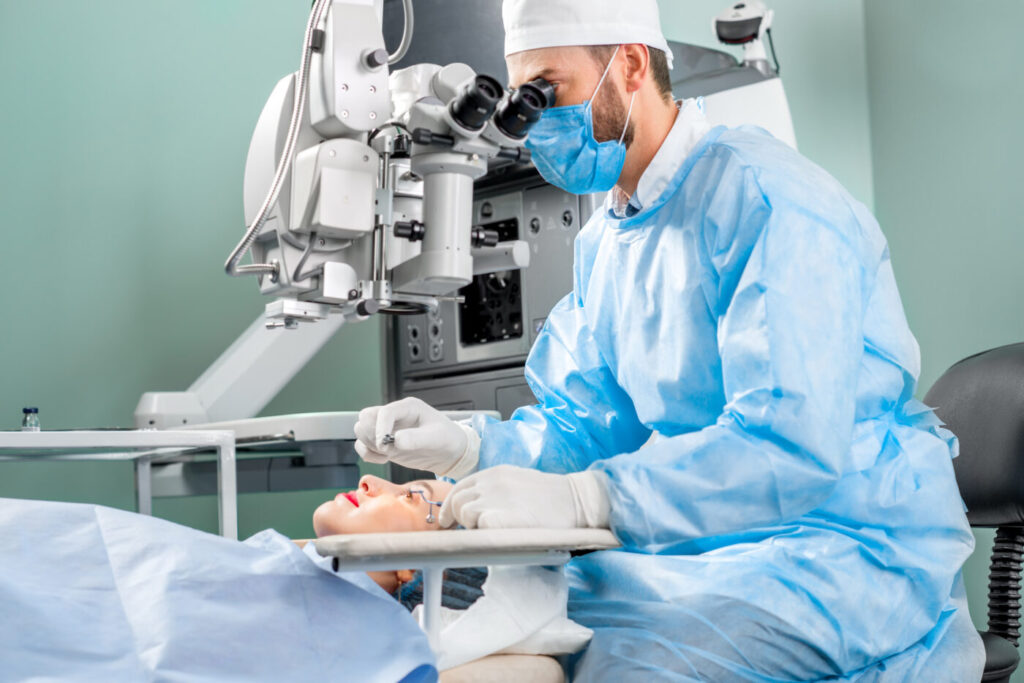In the quest for perfect vision, many turn their sights to laser eye surgery, a revolutionary procedure that promises freedom from glasses and contact lenses. As technology advances and success stories increase, the allure of seeing the world through one’s own eyes, unaided, grows stronger.
Yet, as with any medical procedure, it’s essential to navigate the waters of laser eye surgery with both eyes wide open, aware of the potential risks and rewards that lie ahead. This comprehensive guide aims to illuminate the path for those contemplating this life-changing decision.
What Is Laser Eye Surgery?
Laser eye surgery involves specialized lasers to make precise alterations to the cornea. The goal is to provide a permanent adjustment to the eye’s focusing power. These laser surgeries are popular for their effectiveness, rapid recovery times, and the significant improvement they offer in the quality of life for individuals with vision impairments.
Definition And Types
There are several types of laser eye surgeries, each with their method and advantages, catering to different vision problems and patient needs. The most common types include:
- Laser-Assisted In Situ Keratomileusis (LASIK)
LASIK stands as the most popular and frequently performed laser eye surgery variant. This procedure entails the creation of a slender corneal flap with either a femtosecond laser or a microkeratome blade. The surgeon proceeds to lift this flap, revealing the cornea beneath, and then employs an excimer laser to modify the cornea’s shape.
Once the cornea is appropriately reshaped, the flap is carefully placed back, healing naturally without stitches. Renowned for its rapid healing process and the swift enhancement of vision it offers to many patients, LASIK remains a preferred choice for vision correction.
- Photorefractive Keratectomy (PRK)
PRK stands as an early form of laser eye surgery, sharing LASIK’s objective of altering the cornea’s shape. Unlike LASIK, which involves the creation of a corneal flap, PRK entails the complete removal of the cornea’s outer layer (the epithelium) before the excimer laser is used to reshape the cornea beneath.
The epithelium then naturally heals over several days. For individuals with thinner corneas, for whom creating a flap may not be advisable, PRK is frequently the recommended choice.
- Laser-Assisted Sub-Epithelial Keratomileusis (LASEK)
LASEK represents a modified version of PRK, where a very thin flap is made solely from the corneal epithelium. This flap is delicately moved to the side while an excimer laser reshapes the cornea.
Following this adjustment, the epithelial flap is carefully put back in place and a soft contact lens is applied over it to serve as a protective bandage. Blending elements of both LASIK and PRK, LASEK offers an alternative for individuals with thinner corneas who may not be suitable candidates for LASIK.
- Small Incision Lenticule Extraction (SMILE)
SMILE is a newer technique that represents a significant advancement in laser eye surgery. Instead of using an excimer laser to reshape the cornea, SMILE involves creating a small, lens-shaped piece of tissue (a lenticule) within the cornea using a femtosecond laser.
This lenticule is then removed through a small incision, also made by the laser, effectively changing the shape of the cornea and correcting the refractive error. SMILE is minimally invasive, requiring no flap creation, and is primarily used to correct myopia and astigmatism.

Preparing For Laser Eye Surgery
Preparing for laser eye surgery is a crucial step in the journey towards improved vision. This preparation involves several key actions and decisions, including the following:
Choosing The Right Surgeon
Selecting the right surgeon stands as a critical step in your journey towards laser eye surgery. With this in mind, pay close attention to these key considerations as you choose your eye care doctor:
- Qualifications And Experience: Look for a surgeon who is board-certified in ophthalmology and has extensive experience, specifically in laser eye surgery. Ask about the number of surgeries they’ve performed and their success rates.
- Reputation And Reviews: Research the surgeon’s reputation through patient reviews and testimonials. Word of mouth from friends or family who have undergone successful surgery can also be invaluable.
- Consultation And Communication: Choose a surgeon who offers a thorough pre-surgery consultation. This is an opportunity to assess their professionalism, willingness to answer questions, and ability to explain the procedure, risks, and expected outcomes clearly.
Preparing Yourself Physically And Mentally
Proper preparation can enhance the surgery’s success, minimize the risk of complications and ensure a smooth recovery process. Here’s a pre-surgery checklist you can follow:
- Eye Exam And Measurements: Undergo a comprehensive eye examination to evaluate your vision, corneal thickness, and overall eye health. This exam often includes detailed measurements that will guide the customization of the surgery.
- Medical History Review: Discuss your complete medical history with your surgeon, including any medications you’re taking and any conditions that might affect healing.
- Medication Adjustments: You may need to temporarily stop or adjust certain medications before surgery, as advised by your surgeon.
- Contact Lens Discontinuation: If you wear contact lenses, you’ll likely need to switch to glasses for a period before the surgery. Contact lenses can alter the shape of your cornea, affecting measurements and outcomes.
The Risks Of Laser Eye Surgery
Despite the growing popularity and perceived safety of laser eye surgery, it’s important for individuals considering this option to be aware that, like any surgery, there are inherent risks and possible complications involved. Being well-informed about these risks can help individuals make educated decisions about undergoing the procedure.
Short-Term Side Effects
- Dry Eyes: One of the most common side effects following laser eye surgery is dry eyes. The surgery can temporarily decrease tear production, leading to discomfort and blurred vision. Most patients may need to use lubricating eye drops for a few months after the procedure.
- Glare, Halos, And Double Vision: Some patients may experience increased light sensitivity, glare, halos around lights, or double vision at night. These visual disturbances are usually temporary and tend to diminish within a few weeks or months post-surgery.
- Undercorrections, Overcorrections, And Astigmatism: If the laser removes too little or too much tissue from the eye, it can lead to undercorrections or overcorrections of the original vision problem. Additionally, uneven tissue removal can create or worsen astigmatism. These issues might require additional surgery or the use of glasses or contact lenses.
Long-Term Risks
- Flap Complications (for LASIK): The creation of a corneal flap in LASIK surgery carries risks such as incomplete or uneven flaps or flap dislocation, which can affect vision.
- Regression: In some cases, the eye may gradually revert to its original prescription, a phenomenon known as regression. This might occur months or years after surgery and could necessitate further treatment.
- Keratoconus Or Corneal Ectasia: Rarely, the procedure can weaken the cornea, leading to its progressive thinning and bulging outward, a condition known as keratoconus or post-LASIK corneal ectasia. This can significantly impair vision and might require corneal transplantation.
- Infection And Inflammation: Though rare, there is a risk of infection and inflammation within the eye, which can lead to pain, reduced vision, or other serious complications if not promptly treated.
Who Is At Risk?
Certain factors can increase the likelihood of experiencing complications from laser eye surgery:
- Pre-existing Conditions: Individuals with autoimmune disorders, diabetes, or a history of keloid scarring may have higher risks of complications or slower healing times.
- Thin Corneas: Patients with thin corneas are at increased risk for post-surgical complications, such as corneal ectasia.
- Severe Myopia: Those with very high levels of nearsightedness may have a higher risk of certain complications, including regression and retinal detachment.
- Age And Hormonal Changes: Age and hormonal changes can affect healing and visual outcomes. For instance, women who are pregnant or breastfeeding may experience temporary changes in vision, making them less suitable candidates until their hormonal levels stabilize.
It’s essential for individuals considering laser eye surgery to undergo a comprehensive eye examination and discuss their medical history with a qualified ophthalmologist. This step helps assess their risk for complications and determine if they are good candidates for the surgery.
The Rewards Of Laser Eye Surgery
Laser eye surgery, while accompanied by its risks, offers a range of significant benefits that have made it a popular choice for those seeking to correct their vision. The rewards of undergoing laser eye surgery extend beyond the obvious improvement in visual acuity, touching various aspects of a person’s life.
Success Rates: Statistics And Real-Life Success Stories
Laser eye surgery boasts high success rates, with most patients achieving 20/20 vision or better following the procedure. According to numerous studies and clinical trials, over 95% of LASIK patients express satisfaction with their outcomes—a testament to the procedure’s effectiveness and the positive impact on quality of life.
Real-life success stories abound, with individuals recounting the joy of waking up to clear vision without the need for corrective lenses, participating more freely in sports and outdoor activities, and experiencing a newfound sense of self-confidence.
Life After Surgery: Changes And Improvements
- Freedom From Glasses And Contacts: One of the most celebrated rewards of laser eye surgery is the independence from glasses and contact lenses. This freedom not only simplifies daily routines, such as reading and driving, but also opens new opportunities in hobbies and professions where glasses or contacts might be a hindrance.
- Enhanced Lifestyle And Activities: Patients often report a significant enhancement in their lifestyle post-surgery. Activities like swimming, running, and cycling become more convenient without the worry of losing glasses or dealing with contact lens irritation. Moreover, the ability to see clearly from the moment one wakes up adds invaluable comfort to everyday life.
- Long-Term Cost Savings: While the upfront cost of laser eye surgery might seem substantial, it often proves to be a cost-effective investment over time. The elimination of ongoing expenses related to prescription glasses, contact lenses, solutions, and regular optometrist visits can result in significant savings in the long run.
- Improved Self-Esteem And Confidence: For many, the improvement in vision contributes to an increase in self-esteem and confidence. The freedom from corrective lenses can enhance one’s appearance and open new social and professional opportunities, positively impacting overall well-being.
Cost-Benefit Analysis
When considering laser eye surgery, it’s helpful to conduct a cost-benefit analysis, weighing the initial expense against the long-term advantages. The benefits—ranging from the elimination of glasses and contact lenses to the enhancement of lifestyle and activities—often outweigh the costs for many individuals. Moreover, the emotional and psychological rewards, such as improved self-confidence and the convenience of unaided vision, are invaluable and difficult to quantify.
Conclusion
Navigating the risks and rewards of laser eye surgery demands a well-informed, cautious approach. It’s a decision that holds the power to enhance one’s vision and life significantly but should be made with a complete understanding of the procedure’s complexities. Armed with knowledge, realistic expectations, and a trusted medical professional on one’s side, those considering laser eye surgery can make an empowered choice toward a clearer, brighter future.



